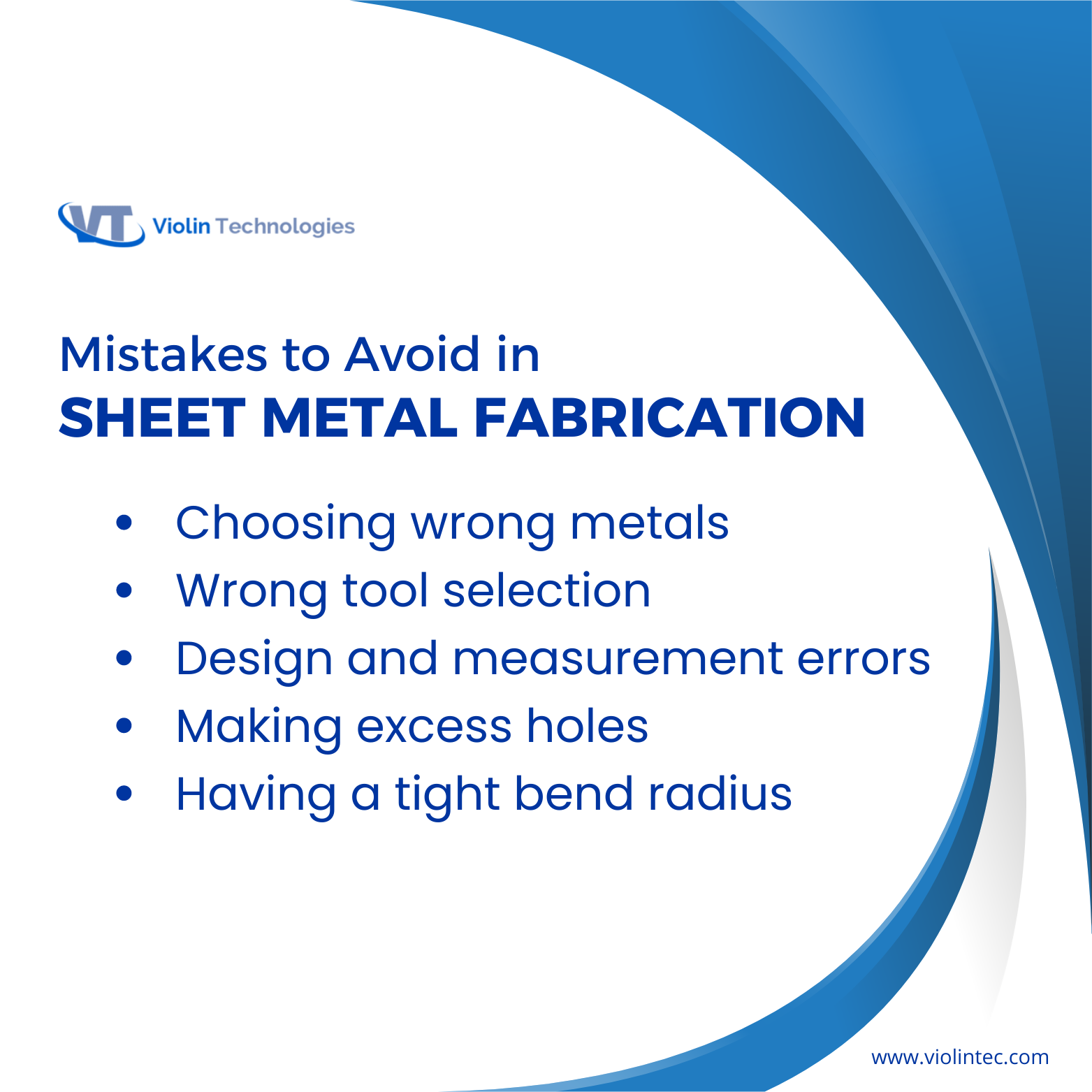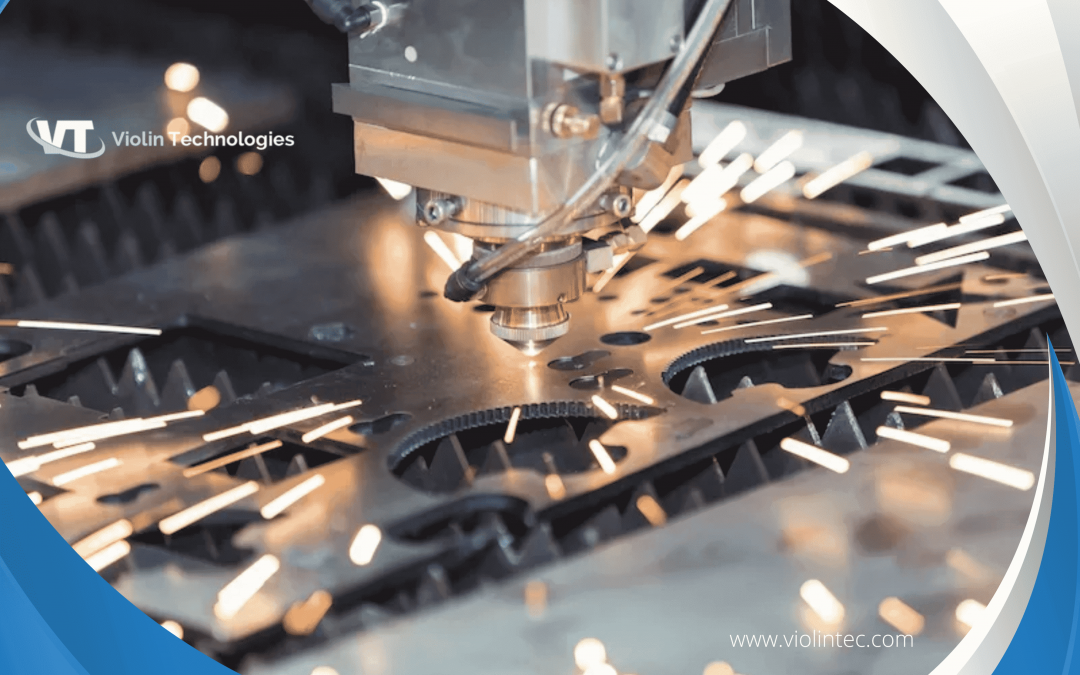In this blog, we’ll look at five typical mistakes in sheet metal manufacturing and offer helpful advice on how to prevent them. We will also learn how sheet metal and stamped parts suppliers can help you achieve excellence in sheet metal fabrication.
What we cover in this blog?
Key Takeaways
- Precision in specifications saves time and money during fabrication..
- Detailed designs ease the manufacturing process and reduce errors.
- Learn from common engineering mistakes to enhance design efficacy.
- Clear communication with manufacturers ensures seamless fabrication.
Common Errors In Sheet Metal Fabrication
Metal fabricators use complicated technology, tools, and equipment to make unique metal products for a variety of industries. Understanding and fixing these common mistakes will help to achieve a smoother, more cost-effective sheet metal production process.
1. Choosing wrong materials
Material selection is a vital step in sheet metal manufacturing. The metal alloy used has a direct impact on the end product’s quality, durability, and cost-effectiveness. Improper material selection can cause structural flaws, product faults, and increased maintenance expenses.
Hence, proper material selection guarantees that the produced components can endure their intended application and environmental conditions. Whether it’s stainless steel for its corrosion protection or aluminum for its lightweight qualities, choosing the appropriate material is critical to attaining the required performance and endurance in sheet metal fabrication projects.
Solution:
Achieving optimal results in sheet metal manufacturing requires a systematic approach to material selection. Begin with a comprehensive analysis of material requirements and consult experienced engineers for insights. Consider factors in environmental conditions and intended use while also conducting cost-benefit analyses. Implement robust quality control measures and collaborate with trusted partners for expertise in selecting the right materials.
2. Poor equipment and tool selection
Using outmoded tools in sheet metal manufacturing can lead to a variety of expensive outcomes. First, production suffers since older equipment is often slower and less efficient, resulting in longer lead times and greater labor expenses. Also, obsolete tools are more prone to mistakes, reducing the precision and quality of manufactured components. Maintenance costs rise when older gear requires more frequent repairs and downtime, which further delays projects.
Solution:
Invest in modern equipment with advanced automation and precision features. Implement Computer-Aided Manufacturing (CAM) software to streamline processes and enhance accuracy. Embrace the Internet of Things (IoT) for real-time equipment monitoring and predictive maintenance. Utilize data analytics to identify performance trends and schedule timely maintenance. Embrace additive manufacturing and laser cutting for intricate designs and precision. Incorporate robotic automation for high-precision tasks to boost productivity and reduce errors.
Hence, investing in modern equipment and technology allows you to avoid these effects while remaining competitive in the sheet metal fabricating sector. Also, if practiced under the supervision of Contract Manufacturers, it can achieve improved efficiency, precision, and cost-effectiveness.
3. Design and measurement errors
Sheet metal fabrication errors can have far-reaching consequences and result in ill-fitting components, jeopardizing the final product’s functionality, structural integrity, and aesthetic finishes. These errors lead to costly rework, delays, and an increased risk of defects, escalating project expenses. Precision and accuracy in sheet metal part design and measurement are therefore imperative to ensure a smooth and efficient fabrication process that runs within budget and project requirements while delivering top-quality end products.
Solution:
Implementing a robust design process involves utilizing CAD files/software for precise 3D modeling, employing skilled engineers to minimize errors, implementing rigorous review processes for double-checking designs, standardizing measurement practices to ensure consistency, integrating quality assurance procedures at every fabrication stage, and providing continuous training to keep the workforce updated with the latest techniques.
Custom cable manufacturers offer comprehensive engineering design services, using advanced technology and experience to create precise, error-free designs for the final part/product.

4. Making excess holes
Your sheet metal can only withstand so many cuts to its surface. These design aspects should be used only when essential. Holes, in particular, are difficult to install in bulk. This is because they complicate the process, and each hole has a high possibility of breaking the sheet metal.
Furthermore, positioning these notches and other characteristics too close to your bent edges may impair the operation of the sheet metal item. For example, holes positioned near a bend radius may lose their ability to retain hardware or resist stress. The ideal strategy is to avoid placing cut features near curves.
Solution:
The ideal strategy is to avoid placing cut features near curves. If you truly need to add one at a bend, try to add it beyond the bend line.
5. Having a Tight Bend Radius
When you bend sheet metal during the manufacturing process, the result is not a precise 90° angle. Instead, the bend has a modest curvature. The bend radius may be calculated by dividing the bend’s length by two.
Consider the bend radius when creating your design. This is because a narrow bend radius creates a weak spot in the sheet metal. A nearly perpendicular bent region can cause your item to break easily. It may also result in a distortion in the proportions of the metal part you’re attempting to produce.
Solution:
Make sure you understand the bend ratios and bending process for the metal you’re using. The minimum bend radius increases with the metal’s hardness and thickness. If you are ignorant of this property, there is a good chance that the metal may break. These fissures will need your products to be modified and refabricated, increasing material wastage and expenses.
Conclusion
It is essential to prevent costly errors during sheet metal fabrication to achieve efficient, cost-effective, and high-quality production. The following key points can help achieve this goal: selecting the right materials, ensuring precise design and measurements, and investing in modern equipment. Quality control is essential, and a skilled workforce is needed to reduce inefficiencies. Companies can improve their processes and reduce mistakes by embracing technology, ultimately saving time and resources.
Frequently Asked Questions
What are the primary design challenges in sheet metal fabrication?
For a flawless product design process, it’s important to be aware of the most common challenges that may arise in tolerancing, embossments/features, material selection, and wrong finish. By addressing these areas with care and attention, we can avoid any mistakes that may cause delays, increased costs, and compromised quality in the final product.
What are the factors to consider when selecting materials for sheet metal parts?
Choosing sheet metal materials involves considering the fabrication process as well as mechanical properties. Consultation with fabrication experts can ensure material selection meets design requirements and manufacturability.
What are the key factors to consider when selecting finishes for sheet metal parts?
Choose standard finishes like powder coating and in-house plating to prevent budget and timeline issues. Avoid using outdated specifications from online sources.
How does tight tolerance impact the fabrication of sheet metal, and what solutions are available?
To exceed tolerances and tensile strength, discuss this with your fabrication partner. Adopt a “sheet metal first” approach, review designs beforehand, and refer to the fabricator’s tolerance documents to overcome these challenges.

Aparna Sushumna
About the Author
Aparna Sushumna, a mother to a hyperactive toddler who is all over the house. I aspire to be a decent content developer. A Bachelorette of technology says my qualification but I anticipated being a singer. Thanks to the recession, I dwelled into various jobs, from coding to being a tech support executive to a help desk professional, only to conclude that there is something else I wish to do. Here I am to accomplish my profound passion for content writing. Music, nature, jewelry, beauty, mythology, life quotes, celebs, and their life, being my areas of interest.

